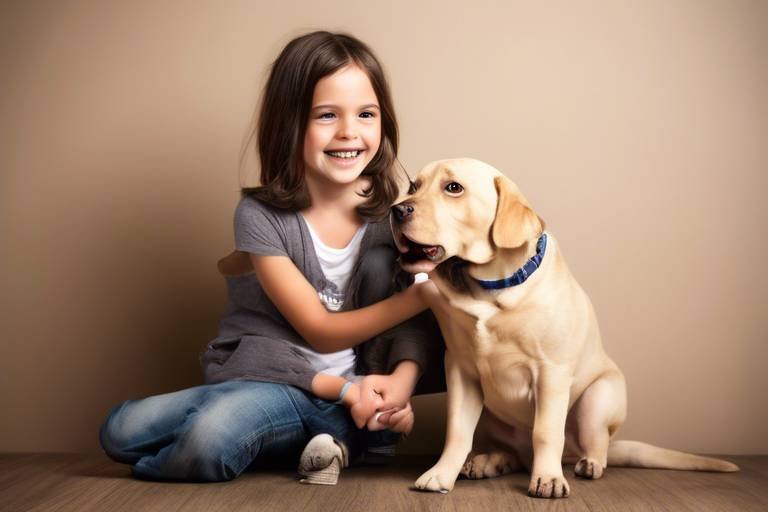How to Recognize and Address Stress in Your New Pet
Bringing a new pet into your home can be an incredibly exciting experience, but it can also come with its own set of challenges. Just like humans, pets can experience stress, and recognizing the signs early on can make all the difference in helping them adjust to their new environment. In this article, we will explore how to identify stress in your new furry friend, the common causes behind their anxiety, and effective strategies to help them settle in comfortably.
Understanding what stress means for pets is crucial. Just as we might feel our heart race or our palms sweat in stressful situations, pets exhibit their own unique signs of distress. Physiologically, a stressed pet might show signs such as increased heart rate, panting, or excessive grooming. Behaviorally, you might notice them hiding, barking excessively, or even displaying aggression. Recognizing these signs is the first step in ensuring your pet feels safe and secure in their new home.
Pets can experience stress from various sources, and understanding these triggers can help owners take proactive measures to alleviate their pet's anxiety. Some common causes of stress include:
- Environmental Changes
- Introducing New Family Members
- Changes in Routine
Moving to a new home or introducing new family members can be overwhelming for pets. The unfamiliar smells, sounds, and sights can create a sense of insecurity. For example, imagine being dropped into a completely new city without any familiar landmarks—your pet feels similarly disoriented. To ease this transition, consider setting up a designated area in your home where your pet can feel safe and gradually introduce them to the rest of the space.
When welcoming a new family member, whether it's a human or another pet, your existing pet may feel threatened or insecure. It's essential to introduce them slowly. Start by allowing them to sniff each other under a door or through a gate. Gradually increase their interaction time while observing their body language closely. Signs of discomfort, such as growling or hiding, should be taken seriously. The goal is to create a harmonious environment where everyone feels secure.
Pets thrive on routine, and disruptions can lead to anxiety. If your daily schedule changes, such as a new work shift or a change in feeding times, your pet may feel unsettled. Think of it like a child whose school schedule suddenly changes; it can be disorienting. To help your pet cope, try to maintain consistency in their feeding, walking, and playtime schedules as much as possible. This predictability can provide them with a sense of security.
Identifying behavioral changes in pets can signal stress. Common behaviors that indicate anxiety include:
- Excessive barking or meowing
- Destructive behavior, like chewing furniture
- Withdrawal or hiding
- Changes in appetite or eating habits
By observing these behaviors, you can gain insights into your pet's emotional state and take the necessary steps to address their needs.
Once stress is recognized, addressing it is vital. There are several effective techniques to help your pet feel more secure and relaxed. One of the first steps is to create a safe space where your pet can retreat when feeling overwhelmed.
Designating a quiet, comfortable area for pets can significantly reduce stress. This space should be away from the hustle and bustle of daily life, equipped with their favorite toys, a cozy bed, and perhaps a piece of your clothing to provide comfort. Think of it as their own little sanctuary—a place where they can escape and recharge when the world feels too chaotic.
Various calming products are available to help alleviate pet stress. Options such as pheromone diffusers, anxiety wraps, and natural supplements can support your pet's emotional well-being. These products work by mimicking natural calming scents or providing gentle pressure, similar to a comforting hug. Always consult with your veterinarian before introducing new products to ensure they are suitable for your pet.
Q: How long does it take for a pet to adjust to a new home?
A: Adjustment periods vary by pet, but it can take anywhere from a few days to a few weeks. Patience and consistency are key.
Q: What should I do if my pet shows signs of extreme stress?
A: If your pet exhibits severe stress signs, consult your veterinarian for advice and potential treatment options.
Q: Can I use over-the-counter products to calm my pet?
A: Many over-the-counter calming products are available, but it's best to consult with your vet to find the most appropriate solution for your pet's specific needs.

Understanding Pet Stress
Recognizing what stress means for pets is crucial for any responsible pet owner. Just like humans, our furry friends can experience a range of emotions, and stress is one of the most common. But how do you know when your pet is feeling stressed? Understanding the physiological and behavioral signs is the first step in ensuring your pet's well-being. Stress in pets can manifest in various ways, and being aware of these signs can help you take action before the situation escalates.
Physiologically, pets may exhibit signs like increased heart rate, excessive panting, or even trembling. These physical symptoms can be alarming, but they are often the body’s way of reacting to stressors. For instance, you might notice your dog pacing back and forth, which is a clear indication that something is bothering them. Additionally, cats may hide or avoid interaction, signaling their discomfort.
Behaviorally, stress can lead to changes in your pet’s normal habits. For example, a normally playful dog might suddenly become withdrawn, or a cat that usually greets you at the door might start hiding under the bed. Here are some common behavioral signs that indicate your pet might be stressed:
- Excessive barking or meowing: This could be a cry for help or a way to express their anxiety.
- Destructive behavior: Chewing on furniture or scratching at doors can be a sign of frustration.
- Changes in eating habits: A stressed pet may eat less or refuse food altogether.
Understanding these signs is essential for any pet owner. It allows you to step in and make necessary changes to your pet’s environment or routine. Remember, stress in pets isn't just a phase; if left unaddressed, it can lead to serious health issues. Just like we wouldn't ignore a friend who seems down, it's crucial to pay attention to our pets and their needs. By being observant and proactive, you can help your pet lead a happier, healthier life.

Common Causes of Stress in Pets
Pets, much like humans, can experience a range of emotions, and stress is one of the most significant. Understanding the common causes of stress in pets is crucial for any pet owner who wants to ensure their furry friend is happy and healthy. Various factors can contribute to a pet's anxiety, and recognizing these triggers can help you provide a more stable environment. Stress in pets often stems from changes in their surroundings or routine, making it essential to be observant and proactive.
One of the primary sources of stress is environmental changes. Imagine moving to a new house; it can be disorienting and overwhelming. Pets experience similar feelings when they are uprooted from their familiar surroundings. New smells, sounds, and sights can bombard their senses, leading to confusion and anxiety. For instance, if you've just moved, your pet may feel unsettled by the new layout of the home or the presence of unfamiliar neighbors. These changes can affect their mental well-being, making it vital to ease their transition into the new environment.
Another significant trigger for stress is the introduction of new family members. Whether it's a new baby, partner, or even another pet, these additions can create feelings of insecurity in your current pets. They might feel like their territory is being invaded or that they are being replaced, which can lead to behavioral issues. It's essential to introduce new family members gradually and positively to minimize stress. For instance, allowing your pet to sniff and explore the new family member at their own pace can help foster a sense of security and acceptance.
Changes in routine can also wreak havoc on a pet's emotional state. Pets thrive on consistency and predictability; they know when it's time to eat, play, or go for a walk. Disruptions to this routine can lead to anxiety and confusion. For example, if your work schedule changes and you suddenly leave the house for longer periods, your pet may feel abandoned or anxious. Maintaining a consistent daily schedule, even during times of change, can significantly help in reducing your pet's stress levels.
In summary, the common causes of stress in pets include:
- Environmental Changes: New homes, unfamiliar smells, and sounds.
- Introducing New Family Members: Feelings of insecurity and territorial disputes.
- Changes in Routine: Disruptions to daily schedules leading to anxiety.
Being aware of these stressors is the first step towards creating a supportive and nurturing environment for your pet. By recognizing the signs of stress and understanding its common causes, you can take proactive measures to help your pet adjust and thrive in their new circumstances.
Q: How can I tell if my pet is stressed?
A: Look for signs such as excessive barking, hiding, changes in appetite, or destructive behaviors. These can indicate that your pet is feeling anxious or stressed.
Q: What should I do if my pet shows signs of stress?
A: It’s important to identify the cause of the stress and address it. Providing a safe space, maintaining a routine, and using calming products can help alleviate their anxiety.
Q: Can stress affect my pet's health?
A: Yes, prolonged stress can lead to health issues such as digestive problems, weakened immune system, and behavioral problems. It’s crucial to manage your pet’s stress effectively.
Environmental Changes
Moving to a new home or experiencing significant changes in their environment can be a major source of stress for pets. Imagine being uprooted from your cozy nook and thrust into an unfamiliar space; it’s no wonder our furry friends can feel overwhelmed! Pets thrive on familiarity, and when their surroundings change, it can disrupt their sense of security. This disruption can lead to a variety of stress-related behaviors, such as excessive barking, hiding, or even destructive actions. Recognizing these signs is the first step toward helping them adjust.
One of the most impactful environmental changes is relocating to a new home. The new smells, sounds, and sights can be exciting yet frightening for pets. They may feel disoriented and anxious, often leading to a sense of loss for their previous environment. To ease this transition, it’s essential to create a sense of continuity amidst the chaos. Here are some strategies to help your pet adapt:
- Maintain Familiarity: Bring along their favorite toys, bedding, and other belongings to provide a sense of comfort.
- Establish a Routine: Stick to their regular feeding and walking schedule as closely as possible to provide structure.
- Explore Gradually: Allow your pet to explore their new environment at their own pace, encouraging them to feel safe in their new surroundings.
Additionally, introducing new family members—be they human or animal—can also heighten the stress levels in pets. They may perceive newcomers as threats to their territory or feel insecure about losing their owner's attention. To promote a smooth transition, consider the following:
- Slow Introductions: Allow pets to meet new family members gradually, ensuring they have a safe space to retreat if they feel overwhelmed.
- Positive Reinforcement: Reward your pet with treats and praise when they interact calmly with the new family member.
By understanding how environmental changes impact your pet's mental well-being and taking proactive measures, you can help create a nurturing atmosphere that promotes a happier, healthier life. Remember, patience is key! Just like us, pets need time to adjust and feel comfortable in their new surroundings. So, be there for them, and soon enough, they’ll find their footing in their new home!
Q: How long does it typically take for a pet to adjust to a new environment?
A: The adjustment period can vary widely depending on the pet's personality and past experiences. Some pets may adapt within a few days, while others might take weeks or even months. It’s essential to be patient and supportive during this time.
Q: Are there specific signs that indicate my pet is stressed due to environmental changes?
A: Yes! Look for signs such as hiding, excessive barking, destructive behavior, loss of appetite, or changes in sleeping patterns. If you notice these behaviors, it’s a good indication your pet is feeling stressed.
Q: What can I do to help my pet feel more secure in a new environment?
A: Create a safe space for your pet with familiar items, maintain a consistent routine, and offer plenty of love and attention. Gradual introductions to new areas and family members can also help ease their anxiety.
Introducing New Family Members
Welcoming a new family member into your home can be an exciting time, but it can also be a source of stress for your furry friends. Just imagine how your pet feels when a new person enters their territory—it's like inviting a stranger into their cozy den! To ensure a smooth transition, it's essential to approach the introduction thoughtfully and compassionately. Here are some strategies to help your pet adjust to the new addition without feeling threatened or insecure.
First and foremost, patience is key. Allow your pet to acclimate to the new family member at their own pace. Start by allowing them to meet in a controlled environment. For instance, keep the new person at a distance initially, letting your pet observe from afar. This gives your pet the chance to assess the situation without feeling overwhelmed. Gradually, as your pet becomes more comfortable, you can shorten the distance and encourage gentle interactions.
Another effective method is to create positive associations. When the new family member is around, engage in activities that your pet enjoys, such as playtime or treats. This helps your pet associate the newcomer with positive experiences. For example, if your new family member offers your dog a favorite toy or a tasty treat, your pet will start to view them as a friend rather than a threat.
It's also important to maintain your pet's routine as much as possible during this transition. Pets thrive on consistency, and a sudden change in their daily schedule can heighten their anxiety. Make sure to keep feeding times, walks, and playtime consistent, even with the new family member in the house. This sense of normalcy can provide reassurance to your pet.
In some cases, introducing new family members, especially children, requires extra caution. Children may not always understand how to approach pets gently. To ensure a harmonious relationship, teach children to respect your pet's space and to interact with them in a calm manner. Always supervise interactions between pets and young children to prevent any accidental stress or harm.
Lastly, if your pet shows signs of stress, such as hiding, excessive barking, or aggression, it’s essential to address these behaviors promptly. Consult with a veterinarian or a pet behaviorist if necessary. They can provide tailored guidance and support to help your pet adjust to their new family dynamics.
By following these strategies, you can create a welcoming and supportive environment for both your new family member and your beloved pet. Remember, the goal is to foster a sense of security and harmony within your home, ensuring that everyone, including your pet, feels like a valued part of the family.
- How long does it take for a pet to adjust to a new family member? Every pet is different, but it can take anywhere from a few days to several weeks. Patience and gradual introductions are crucial.
- What if my pet shows aggression towards the new family member? It's important to address aggressive behavior immediately. Consult a veterinarian or a professional trainer for guidance.
- Can calming products help during the introduction? Yes, calming products like pheromone diffusers can help reduce anxiety and create a more relaxed atmosphere for your pet.
Changes in Routine
Pets are creatures of habit, and just like us, they thrive on routine. When their daily schedules are disrupted, it can feel like the ground has shifted beneath their paws. Imagine waking up one morning and finding that your entire day has been flipped upside down—no coffee, no morning jog, and no time with your favorite people. That’s how your pet might feel when there are changes in their routine. Whether it’s a new work schedule for you, a shift in meal times, or a change in their exercise regimen, these disruptions can lead to feelings of anxiety and confusion.
For instance, if you usually take your dog for a walk at 7 AM and suddenly shift it to 5 PM, your furry friend might not understand why their beloved routine has changed. This can lead to restlessness, excessive barking, or even destructive behaviors as they try to cope with the uncertainty. It’s essential to recognize that these behavioral changes are their way of expressing distress. Just like a child might throw a tantrum when faced with unexpected changes, pets can also react negatively to sudden shifts in their environment.
To help your pet adjust to changes in routine, here are some effective strategies:
- Gradual Adjustments: If you know a change is coming, try to gradually shift your pet’s routine over a few days. For example, if you need to change their feeding schedule, start by moving it by 15 minutes each day until you reach the desired time.
- Maintain Consistency: While some aspects of the routine may change, try to keep other elements consistent. For example, if your pet’s walk time changes, ensure that their playtime and feeding schedule remain the same.
- Provide Enrichment Activities: Engage your pet with toys, puzzles, or new games to distract them from the changes. Mental stimulation can help alleviate anxiety and keep their minds occupied.
Furthermore, it’s also crucial to communicate with your pet. Although they may not understand your words, your tone and body language can convey reassurance. Spend extra time with them during transitions, offering comfort and affection. This bond can help them feel secure, even when their routine is in flux. Remember, patience is key. Just as humans need time to adapt to new situations, so do our pets.
In summary, changes in routine can be stressful for pets, but with a little foresight and care, you can help them navigate these transitions smoothly. By gradually introducing changes, maintaining consistency where possible, and providing plenty of love and attention, you can ensure that your furry friend remains happy and healthy, even in the face of life’s little upheavals.
Behavioral Signs of Stress
When it comes to our furry friends, understanding their is crucial for their well-being. Pets, much like humans, exhibit a range of behaviors that can indicate they are feeling anxious or overwhelmed. These signs can sometimes be subtle, but recognizing them early can make a world of difference. Imagine your pet as a little actor, performing a play where their discomfort is the main theme. By tuning into their performance, you can help them find their way back to a more relaxed state.
One common sign of stress is excessive barking or meowing. If your normally quiet pet suddenly becomes vocal, it may be a cry for help. This vocalization can be a way for them to express their discomfort or anxiety. Similarly, destructive behavior, such as chewing furniture or scratching at doors, often indicates that your pet is trying to cope with their stress. Think of it as a child throwing a tantrum; they are acting out because they don’t know how to express their feelings in a more constructive way.
Another behavioral change to watch for is withdrawal. If your pet, who usually loves to be around you, suddenly starts hiding or seeking solitude, it could be a sign of stress. They might be feeling overwhelmed by their environment or the changes happening around them. Additionally, changes in eating habits can also indicate stress. If your pet is refusing to eat or overeating, it’s essential to pay attention. Just like humans might lose their appetite or binge-eat during stressful times, pets can exhibit similar behaviors.
Physical signs often accompany these behaviors. For instance, you might notice your pet panting excessively or showing signs of trembling. These physical manifestations can be alarming and should not be ignored. Furthermore, excessive grooming or licking can also indicate that your pet is trying to soothe themselves. This compulsive behavior can lead to skin irritations and other health issues, so it’s important to address the root cause of their stress.
To help you better understand these signs, here’s a quick reference table:
| Behavioral Sign | Possible Interpretation |
|---|---|
| Excessive barking or meowing | Expression of discomfort or anxiety |
| Destructive behavior | Coping mechanism for stress |
| Withdrawal or hiding | Overwhelm from environment or changes |
| Changes in eating habits | Response to stress |
| Panting or trembling | Physical response to anxiety |
| Excessive grooming or licking | Self-soothing behavior |
By keeping an eye out for these signs, you can take proactive steps to help your pet feel more secure and comfortable in their environment. Remember, just like us, pets need time to adjust to changes, and being attuned to their emotional state can foster a deeper bond between you and your furry companion.
Q: How can I tell if my pet is stressed?
A: Look for changes in behavior such as excessive barking, withdrawal, or changes in eating habits. Physical signs like panting or trembling can also indicate stress.
Q: What should I do if I notice my pet is stressed?
A: Create a calm environment, maintain a consistent routine, and consider using calming products. If the stress persists, consult your veterinarian.
Q: Can stress in pets lead to health issues?
A: Yes, prolonged stress can lead to various health problems, including anxiety disorders, digestive issues, and skin conditions.
Q: How long does it take for a pet to adjust to a new environment?
A: Each pet is different, but it can take anywhere from a few days to several weeks for them to fully adjust. Patience and understanding are key.

Effective Stress Management Techniques
Once you've recognized that your pet is stressed, the next step is to take action! Addressing stress in pets is not just about alleviating their immediate discomfort; it's about fostering a long-term sense of security and happiness. There are several effective techniques you can implement to help your furry friend feel more at ease in their environment. By creating a nurturing atmosphere, you can significantly improve your pet's emotional well-being.
One of the first things you can do is to create a safe space for your pet. This is a designated area where they can retreat when feeling overwhelmed. Think of it as their little sanctuary—somewhere cozy and quiet. To set up this safe haven, consider the following:
- Choose a quiet room or corner of your home.
- Add a comfortable bed or blanket where they can snuggle.
- Include their favorite toys to make the space inviting.
- Ensure the area is free from loud noises and distractions.
Having a safe space allows your pet to decompress and regain their composure when the world feels a bit too hectic.
Another effective strategy involves the use of calming products. There are a variety of products designed to help reduce anxiety in pets, and they can be a game-changer. Here’s a quick overview of some popular options:
| Product Type | Description |
|---|---|
| Pheromone Diffusers | These release calming pheromones that mimic those produced by mother animals. |
| Anxiety Wraps | These snug-fitting garments provide a sense of security, similar to swaddling a baby. |
| Natural Supplements | Herbal remedies and calming treats can help soothe anxious pets. |
When choosing a calming product, it's important to consider your pet's specific needs and consult with your veterinarian to ensure the best fit for your furry companion.
In addition to these techniques, maintaining a consistent routine can greatly help in managing your pet's stress levels. Pets thrive on predictability, and a stable schedule can provide them with a sense of security. Try to keep feeding times, walks, and play sessions as consistent as possible. If you need to make changes, do so gradually to allow your pet to adjust.
Lastly, don’t underestimate the power of positive reinforcement. Rewarding your pet for calm behavior can encourage them to feel more relaxed. Use treats, praise, or extra playtime to reinforce their good behavior when they are in their safe space or when they encounter potentially stressful situations. This not only builds their confidence but also strengthens your bond.
In summary, addressing stress in your pet involves a multifaceted approach. By creating a safe space, utilizing calming products, maintaining a consistent routine, and employing positive reinforcement, you can help your beloved pet navigate their feelings of anxiety. Remember, it’s all about creating a supportive environment that fosters their emotional well-being!
Q: How can I tell if my pet is stressed?
A: Look for changes in behavior such as excessive barking, hiding, or destructive actions. Physical signs may include panting, drooling, or changes in appetite.
Q: Can I use calming products for all pets?
A: While many calming products are safe for most pets, it’s best to consult with your veterinarian to determine what’s appropriate for your specific animal.
Q: How long does it take for calming products to work?
A: The time can vary depending on the product and your pet's individual response. Some may notice effects within hours, while others may take a few days.
Q: Is it normal for pets to feel stressed during transitions?
A: Absolutely! Just like humans, pets can feel anxious during changes. It's important to be patient and supportive as they adjust.
Creating a Safe Space
When it comes to helping your new pet feel secure, is one of the most effective strategies you can employ. Think of this space as a cozy sanctuary where your pet can retreat when the world feels overwhelming. Just like we all need a quiet corner to unwind after a long day, pets also thrive when they have a designated area that feels like their own. This space should be calm, comfortable, and free from distractions, allowing your furry friend to relax and recharge.
To set up a safe haven for your pet, start by choosing a location that is away from the hustle and bustle of daily life. This could be a quiet room or a corner of your living area, but make sure it’s a place where your pet can feel undisturbed. You might want to consider using a crate or a pet bed, as these can provide a sense of security. Just like a child's fort, a crate can become a comforting hideaway for your pet, giving them a sense of control over their environment.
Next, fill this safe space with familiar items that smell like home. Pets are incredibly sensitive to scents, and having their favorite blanket or toy nearby can provide a sense of comfort. Consider the following elements when creating this sanctuary:
- Comfortable Bedding: A soft bed or blanket can make all the difference in helping your pet feel at ease.
- Familiar Toys: Including their favorite toys can help distract them from anxiety and promote playfulness.
- Calm Environment: Keep the area quiet and free from loud noises or sudden disturbances.
- Accessibility: Ensure that your pet can easily access their safe space whenever they need it.
Once you’ve established this safe space, it’s important to encourage your pet to use it. You can do this by introducing them to the area gradually, using treats or toys to lure them in. It’s essential to make this space a positive experience. You might even sit with them for a while, offering gentle pets and soothing words to reinforce that this is a place of safety and comfort.
Remember, patience is key. Some pets may take a little longer to embrace their safe space than others. If your pet seems hesitant, don’t force them. Instead, allow them to explore at their own pace. Over time, they will learn that this area is their personal retreat, a place where they can escape the chaos and simply be themselves.
In addition to creating a physical safe space, consider incorporating calming techniques such as soft music or white noise machines to further enhance the environment. These auditory elements can help drown out any stress-inducing sounds from outside, contributing to a more peaceful atmosphere.
Ultimately, a safe space is about fostering a sense of security and comfort for your pet. By providing them with a sanctuary that they can call their own, you are taking a significant step toward helping them adjust to their new home. This simple yet powerful approach can lead to a happier, more relaxed pet, allowing them to thrive in their new environment.
Q: How can I tell if my pet is using their safe space?
A: Look for signs such as your pet spending time there voluntarily, resting comfortably, or playing with toys in that area. If they seem relaxed and content, they are likely using their safe space effectively.
Q: What if my pet refuses to go into their safe space?
A: If your pet is hesitant, try making the space more inviting with treats, toys, or even sitting with them until they feel comfortable. Avoid forcing them into the space, as this can create negative associations.
Q: Can I use calming products in the safe space?
A: Absolutely! Products like pheromone diffusers or calming sprays can enhance the environment and help soothe anxious pets. Just ensure that they are safe and appropriate for your specific type of pet.
Using Calming Products
When it comes to helping your furry friend combat stress, calming products can be a game changer. Just like we sometimes need a little extra help to unwind, pets can benefit from various tools designed to soothe their nerves. These products come in a range of forms, each catering to different needs and preferences. For instance, you might find pheromone diffusers that mimic natural calming scents, or anxiety wraps that provide gentle, reassuring pressure. It’s like giving your pet a warm hug when they need it most!
One popular option is the use of pheromone diffusers. These devices release synthetic versions of the calming pheromones that mother dogs or cats produce to comfort their young. By creating a familiar and soothing atmosphere, these diffusers can help reduce anxiety and promote relaxation. They are particularly effective in high-stress situations, such as during thunderstorms or fireworks. Just plug it in, and let it work its magic!
Another effective tool is the anxiety wrap, which is designed to apply gentle pressure around your pet’s body. This pressure can have a calming effect, similar to swaddling a baby. Many pet owners have found that these wraps significantly decrease their pets' anxiety levels during stressful events. It’s essential to ensure the wrap fits properly to maximize its effectiveness—think of it as a snug, comforting hug that helps your pet feel secure.
Additionally, natural supplements are becoming increasingly popular among pet owners. These products often contain ingredients like chamomile, valerian root, or L-theanine, which are known for their calming properties. Before introducing any supplement, however, it’s crucial to consult with your veterinarian to ensure it’s safe and appropriate for your pet's specific needs. Just like with any medication or supplement, what works wonders for one pet may not be suitable for another.
Here’s a quick comparison of some common calming products:
| Product Type | How It Works | Best For |
|---|---|---|
| Pheromone Diffusers | Releases calming scents | General anxiety |
| Anxiety Wraps | Provides gentle pressure | Situational stress (thunderstorms, travel) |
| Natural Supplements | Contains calming herbs | Chronic anxiety |
In conclusion, integrating calming products into your pet's routine can significantly enhance their ability to cope with stress. Always remember to observe how your pet reacts to these products and adjust accordingly. Sometimes, it might take a little trial and error to find the perfect solution for your furry friend. With the right approach, you can help your pet navigate through their anxious moments, ensuring they feel loved, secure, and comfortable in their home.
- What are the signs that my pet is stressed? Look for changes in behavior such as excessive barking, hiding, or changes in eating habits.
- How long does it take for calming products to work? This can vary; some products may show immediate results, while others might take a few days to have an effect.
- Are calming products safe for all pets? Most calming products are safe, but it’s best to consult your veterinarian before starting any new treatment.
Frequently Asked Questions
- What are the signs of stress in pets?
Pets often show stress through various physical and behavioral signs. Look for changes such as excessive barking, hiding, changes in appetite, or destructive behavior. If your pet seems unusually withdrawn or anxious, it may be experiencing stress. Remember, each pet is unique, so pay attention to their usual behavior to spot any changes.
- How can I help my new pet adjust to a new environment?
Helping your new pet adjust involves creating a calm and safe environment. Start by designating a quiet space where they can retreat when feeling overwhelmed. Gradually introduce them to different areas of your home and family members, allowing them to explore at their own pace. Consistency in routine can also help ease their anxiety as they settle in.
- What should I do if my pet is stressed after moving?
If your pet shows signs of stress after moving, be patient and give them time to adjust. Maintain their regular feeding and walking schedule to provide a sense of security. You might also consider using calming products like pheromone diffusers or anxiety wraps to help soothe them during this transition.
- How do I introduce a new family member to my pet?
Introducing a new family member to your pet should be done gradually. Start by allowing your pet to sniff the new person from a distance. Use treats and positive reinforcement to create a positive association. Supervise their interactions initially and ensure your pet has a safe space to retreat if they feel overwhelmed.
- Can changes in routine affect my pet's behavior?
Absolutely! Pets thrive on routine, and any changes can lead to stress and anxiety. If you know a change is coming, try to prepare your pet by gradually adjusting their schedule. Keeping feeding and exercise times consistent can help them feel more secure during transitions.
- What calming products are effective for stressed pets?
There are several calming products that can help alleviate pet stress. Options include pheromone diffusers, which release calming scents, anxiety wraps that provide gentle pressure, and natural supplements designed to promote relaxation. Always consult your veterinarian before trying new products to ensure they are suitable for your pet.



















